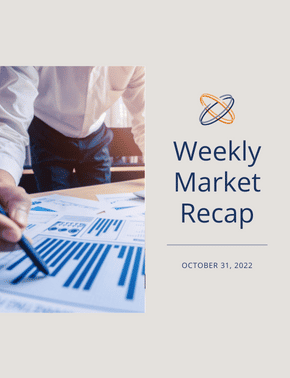Week in Review
Equity Markets:
The S&P rallied this week, despite some disappointing earnings reports from major tech companies. The S&P ended the week up 4%. The Dow Jones outperformed the other major indices following strong earnings from the energy and industrials sectors and ended the week up by 5.7%
We are in the heart of earnings season. So far, 52% of S&P 500 companies have reported. 71% have beaten earnings expectations and 68% have beaten revenue expectations. Both of these are slightly below the 5- and 10-year averages but remain better than feared.
Fixed Income Markets:
The 10-year treasury yield ended the week at 4.02% after seeing levels above 4.3% the previous week. The 2-year treasury yield ended the week at 4.47%. The yield curve has inverted more severely. The 3-month / 10-year spread closed in negative territory for the first time since 2019. This inversion is considered to be a more reliable signal for an economic slowdown in the academic world. The 3-month bill ended the week with a yield of 4.11%.
On a global central bank note, the Canadian Central Bank surprised economists by slowing their rate hikes by 0.25%. Economists broadly expected a 0.75% hike, but Canadian Policymakers decided against it. They indicated that the outsized hikes are likely a thing of the past, but more hikes should be expected into next year.
Economic:
Core PCE came in just below expectations at 5.1% versus the expected 5.2%. This is a closely watched reading by the Fed, being one of the preferred indicators of inflationary impacts on everyday life for the American consumer. This remains elevated which doesn’t lead to expectations of a strong pivot in the policy. The housing market continues its cooling streak. Pending home sales fell more than 10% in September. This was 2.5x the expected Bloomberg decline of -4%.
The University of Michigan Consumer Sentiment Index final reading was revised upward to 59.9. After seeing a historic low in the index in early summer, sentiment has steadily marched up. The consumer has remained resilient despite the heavy impacts of inflation, but savings rates have dropped which could indicate the beginning of some consumer stress. The savings rate for September was 3.1%, down from August’s 3.5% savings rate.
Looking Ahead
Equity Markets:
The S&P 500 has rallied 7% since the low earlier in the month. This is partly due to the oversold, extremely negative sentiment, as well as an upbeat earnings season thus far. From a historical standpoint, this earnings season is less than stellar but is much better than feared. The blended earnings growth currently sits at 2.2%, according to FactSet. This is lower than the 5- and 10-year averages of 8.7% and 6.5%, respectively.
At the beginning of the year, S&P 500 consensus earnings were 250. Today, they are 11% lower at 222, according to Yardeni Research. Analyst expectations have started to come in line with the environment as of late. This can be seen in some of the Q3 earnings reports where there has been some weakness but has resulted in a strong showing when compared to expectations.
The volatility trend we have seen in 2022 will likely remain through the end of the year. We believe that investors should remain committed to their long-term investment objectives. We are currently 20% below the early January high, but the current low from earlier in the month nearly touched -28%. This is on par with the historical recessionary drawdowns of 30%. Diversification across sectors should mitigate the risk of missing the reversal when we start a new uptrend, and should help reduce downside capture if we see a lower low.
Fixed Income Markets:
The headline event for the week will be the FOMC meeting that takes place Tuesday and will culminate on Wednesday with Chairman Powell’s press conference where he will reveal the policy rate decision. The markets are anticipating another 0.75% increase. The likelihood of anything higher is low in our minds. If the Fed follows in the Bank of Canada’s footsteps and increases by anything less it could be a catalyst for a bond and equity rally.
We believe that we are near the peak in rates for the current cycle. The 10-year treasury yield started 2022 at 1.6%. The yield has increased by roughly 170%. This is a historic move and, in our opinion, is not sustainable in the long run. We still believe we are better buyers of bonds than sellers in the current rate environment. You should speak with your Advisor on whether this is appropriate for your portfolio.
Economic:
The ISM & S&P Global PMI Index will be released for the manufacturing and services sectors. The JOLTS report will be released on Tuesday and should provide timely insight into what appears to be a moderating labor market.
Important Disclosures:
Investment Advisory Services offered through Krilogy®, an SEC Registered Investment Advisor. Please review all prospectuses and Krilogy’s Form ADV 2A carefully prior to investing. This is neither an offer to sell nor a solicitation of an offer to buy the securities described herein. An offering is made only by a prospectus to individuals who meet minimum suitability requirements.
All expressions of opinion are subject to change. This information is distributed for educational purposes only, and it is not to be construed as an offer, solicitation, recommendation, or endorsement of any particular security, products, or services. Diversification does not eliminate the risk of market loss. Investments involve risk and unless otherwise stated, are not guaranteed. Investors should understand the risks involved of owning investments, including interest rate risk, credit risk and market risk. Investment risks include loss of principal and fluctuating value. There is no guarantee an investing strategy will be successful. Past performance is not a guarantee of future results. Indices are not available for direct investment; therefore, their performance does not reflect the expenses associated with the management of an actual portfolio. The S&P data is provided by Standard & Poor’s Index Services Group.
Services and products offered through Krilogy® are not insured and may lose value. Be sure to first consult with a qualified financial advisor and/or tax professional before implementing any strategy discussed herein.




















